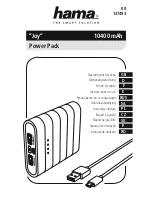
GMC-I Messtechnik GmbH
63
Note
Memory locations 11 through 253
can be recalled by means of
interface programming, even if the
sequence has not been
opened
.
If an
invalid (empty) memory location
is accessed in sequence
memory, command
execution
is
aborted
.
Err 21
appears at the display, and
bit 5
is set in event register B
(
SEQE
, SEQuence error).
If
a
USET
or
ISET
parameter exceeds the
ULIM
or
ILIM
limit value
during recall,
Err 21
appears at the display and
bit 5
is set in
event register B (
SEQE
, SEQuence error).
As is the case with all other memory locations with an address
of greater than 10, addresses 254 and 255 can be stored with
*SAV and used for device configuration with *RCL.
*RST – Reset Device Settings
Function and manual operation:
See explanation on page 47.
Programming
Setting command:
*
RST
Example
(HP-Basic):
OUTPUT 713;"*RST"
Default settings:
OUTPUT OFF
Output deactivated
USET 0
Voltage setpoint = 0
ISET 0
Current setpoint = 0
OVSET max
Max. overvoltage protection trigger value
ULIM unom
USET limit value = nominal voltage
ILIM inom
ISET limit value = nominal current
OCP OFF
Current limiting by means of current
regulation
DELAY 0
Output is deactivated immediately in
event of CC
TSET 0
(=tdef)
Sequence dwell time = default duration
SEQUENCE OFF
Sequence function deactivated
DISPLAY ON
Display activated
MINMAX OFF
No Min-Max value recording
TDEF
0.01
REPETITION
0 (= cont.)
START_STOP
011, 011
POWER ON
Unchanged
T_MODE
Unchanged
Stored parameters:
SETUP memory locations
1 ... 10
Unchanged
SEQUENCE memory
Unchanged
DDT register
Cleared
MINMAX memory
Reset
Parameter settings
Reset to default settings
Addressing status
Unchanged
Input and output buffers
Unchanged
Service request SRQ
Unchanged
Status byte register STB
Unchanged
Event registers ESR, ERA, ERB
Unchanged
Enable registers ESE, ERAE, ERBE, SRE, PRE
Unchanged
*SAV – Saving Device Settings
Function and manual operation:
See explanation in chapter 4.9.
Programming
Setting command:
*SAV
n
Parameter:
n (memory location number)
Parameter type:
Integer
Setting range:
0
*SAV 0 (display for manual
operation: Sto clr) clears
contents of the sequence
memory from the start address
to the stop address.
1 to 10
Current device settings are saved
to the selected SETUP register.
11 to 253
Current SEq parameter settings
are saved to the selected
sequence memory location.
254
Reference value U_Lo, I_Lo
255
Reference value U_Hi, I_Hi
Default setting:
After RESET (*RST)
Memory location number: n/a
Memory location contents: unchanged
Example
(HP Basic):
OUTPUT 713;"*SAV 3"
{current device setting is saved to
memory location 3}
*STB? – Status Byte Register Query
Functions
Read out
register contents
(see also chapter 6.3 on page 60 and table:
“Query Commands for Status and Events Management” on page 86)
:
– The
status of group messages
from the three event registers
ESR
,
ERA
and
ERB
(bits 2, 3 and 5)
– The
status of the output buffer
(not empty
➭
bit 4
MAV
= 1,
empty
➭
bit 4
MAV
= 0)
– The
status
of the
MSS
group message masked with the
SRE
enable register from internal bits 2 through 5
– Bits 0, 1 and 7 are not used, and are always set to “0”.
When using the RS232 interface
without
the IEEE488 interface
value 1 is generally returned as a response.
Programming
Query command:
*STB?
Response string:
n
(decimal equivalent)
Value:
16
n
124
Length:
3 characters, fixed
Example (HP Basic):
OUTPUT 713; "*IST"
ENTER 713; A$; DISP A$
Display:
034 {034
2
= 0001 1000
10
}
Note
A message is always made available as a result of the query.
The response string is stored to the output buffer.
The
MAV
bit is set for this reason.
The value of
n
is always
16 in this case.
The
*CLS
command clears the status byte register.
However, the
MAV
bit is not cleared.
Содержание SSP 120 Series
Страница 2: ...2 GMC I Messtechnik GmbH ...
















































